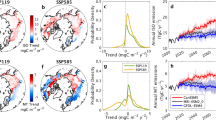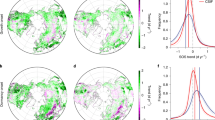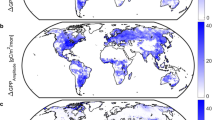Abstract
Terrestrial vegetation releases large quantities of plant volatiles into the atmosphere that can then oxidize to form secondary organic aerosol. These particles affect plant productivity through the diffuse radiation fertilization effect by altering the balance between direct and diffuse radiation reaching the Earth’s surface. Here, using a suite of models describing relevant coupled components of the Earth system, we quantify the impacts of biogenic secondary organic aerosol on plant photosynthesis through this fertilization effect. We show that this leads to a net primary productivity enhancement of 1.23 Pg C yr−1 (range 0.76–1.61 Pg C yr−1 due to uncertainty in biogenic secondary organic aerosol formation). Notably, this productivity enhancement is twice the mass of biogenic volatile organic compound emissions (and ~30 times larger than the mass of carbon in biogenic secondary organic aerosol) causing it. Hence, our simulations indicate that there is a strong positive ecosystem feedback between biogenic volatile organic compound emissions and plant productivity through plant-canopy light-use efficiency. We estimate a gain of 1.07 in global biogenic volatile organic compound emissions resulting from this feedback.
This is a preview of subscription content, access via your institution
Access options
Access Nature and 54 other Nature Portfolio journals
Get Nature+, our best-value online-access subscription
$29.99 / 30 days
cancel any time
Subscribe to this journal
Receive 12 print issues and online access
$259.00 per year
only $21.58 per issue
Buy this article
- Purchase on Springer Link
- Instant access to full article PDF
Prices may be subject to local taxes which are calculated during checkout




Similar content being viewed by others
References
Guenther, A. et al. A global model of natural volatile organic compound emissions. J. Geophys. Res. Atmos. 100, 8873–8892 (1995).
Carslaw, K. S. et al. A review of natural aerosol interactions and feedbacks within the Earth system. Atmos. Chem. Phys. 10, 1701–1737 (2010).
Arneth, A. et al. Terrestrial biogeochemical feedbacks in the climate system. Nat. Geosci. 3, 525–532 (2010).
Niinemets, Ü., Tenhunen, J. D., Harley, P. C. & Steinbrecher, R. A model of isoprene emission based on energetic requirements for isoprene synthesis and leaf photosynthetic properties for Liquidambar and Quercus. Plant Cell Environ. 22, 1319–1335 (1999).
Heald, C. L. et al. Predicted change in global secondary organic aerosol concentrations in response to future climate, emissions, and land use change. J. Geophys. Res. Atmos. 113, D05211 (2008).
Peñuelas, J. & Staudt, M. BVOCs and global change. Trends Plant. Sci. 15, 133–144 (2010).
Paasonen, P. et al. Warming-induced increase in aerosol number concentration likely to moderate climate change. Nat. Geosci. 6, 438–442 (2013).
Laothawornkitkul, J., Taylor, J. E., Paul, N. D. & Hewitt, C. N. Biogenic volatile organic compounds in the Earth system. New Phytol. 183, 27–51 (2009).
Scott, C. E.et al. Impact on short-lived climate forcers increases projected warming due to deforestation. Nat. Commun. 9, 157 (2018).
Rap, A. et al. Natural aerosol direct and indirect radiative effects. Geophys. Res. Lett. 40, 3297–3301 (2013).
Scott, C. E. et al. The direct and indirect radiative effects of biogenic secondary organic aerosol. Atmos. Chem. Phys. 14, 447–470 (2014).
Roderick, M. L., Farquhar, G. D., Berry, S. L. & Noble, I. R. On the direct effect of clouds and atmospheric particles on the productivity and structure of vegetation. Oecologia. 129, 21–30 (2001).
Gu, L. H. et al. Response of a deciduous forest to the Mount Pinatubo eruption: enhanced photosynthesis. Science 299, 2035–2038 (2003).
Cirino, G. G., Souza, R. A. F., Adams, D. K. & Artaxo, P. The effect of atmospheric aerosol particles and clouds on net ecosystem exchange in the Amazon. Atmos. Chem. Phys. 14, 6523–6543 (2014).
Rap, A. et al. Fires increase Amazon forest productivity through increases in diffuse radiation. Geophys. Res. Lett. 42, 4654–4662 (2015).
Mercado, L. M. et al. Impact of changes in diffuse radiation on the global land carbon sink. Nature 458, 1014–1017 (2009).
Zhang, Q. et al. Ubiquity and dominance of oxygenated species in organic aerosols in anthropogenically-influenced Northern Hemisphere midlatitudes. Geophys. Res. Lett. 34, L13801 (2007).
Jimenez, J. L. et al. Evolution of organic aerosols in the atmosphere. Science 326, 1525–1529 (2009).
Kulmala, M. N. et al. CO2-induced terrestrial climate feedback mechanism: from carbon sink to aerosol source and back. Boreal. Environ. Res. 19, 122–131 (2014).
Mann, G. W. et al. Description and evaluation of GLOMAP-mode: a modal global aerosol microphysics model for the UKCA composition–climate model. Geosci. Model Dev. 3, 519–551 (2010).
Edwards, J. M. & Slingo, A. Studies with a flexible new radiation code. 1. Choosing a configuration for a large-scale model. Q. J. R. Meteorol. Soc. 122, 689–719 (1996).
O’Sullivan, M. et al. Small global effect on terrestrial net primary production due to increased fossil fuel aerosol emissions from East Asia since the turn of the century. Geophys. Res. Lett. 43, 8060–8067 (2016).
Arneth, A., Monson, R. K., Schurgers, G., Niinemets, Ü. & Palmer, P. I. Why are estimates of global terrestrial isoprene emissions so similar (and why is this not so for monoterpenes)? Atmos. Chem. Phys. 8, 4605–4620 (2008).
Schurgers, G., Arneth, A., Holzinger, R. & Goldstein, A. H. Process-based modelling of biogenic monoterpene emissions combining production and release from storage. Atmos. Chem. Phys. 9, 3409–3423 (2009).
Guenther, A. B. et al. The Model of Emissions of Gases and Aerosols from Nature version 2.1 (MEGAN2.1): an extended and updated framework for modeling biogenic emissions. Geosci. Model. Dev. 5, 1471–1492 (2012).
Tsigaridis, K. et al. The AeroCom evaluation and intercomparison of organic aerosol in global models. Atmos. Chem. Phys. 14, 10845–10895 (2014).
Bey, I. et al. Global modeling of tropospheric chemistry with assimilated meteorology: model description and evaluation. J. Geophys. Res. Atmos. 106, 23073–23095 (2001).
Liao, H., Henze, D. K., Seinfeld, J. H., Wu, S. & Mickley, L. J. Biogenic secondary organic aerosol over the United States: comparison of climatological simulations with observations. J. Geophys. Res. Atmos. 112, D06201 (2007).
Pye, H. O. T., Chan, A. W. H., Barkley, M. P. & Seinfeld, J. H. Modeling of organic aerosol: the importance of reactive nitrogen (NOx and NO3). Atmos. Chem. Phys. 10, 11261–11276 (2010).
Sitch, S. et al. Recent trends and drivers of regional sources and sinks of carbon dioxide. Biogeosciences 12, 653–679 (2015).
Strada, S. & Unger, N. Potential sensitivity of photosynthesis and isoprene emission to direct radiative effects of atmospheric aerosol pollution. Atmos. Chem. Phys. 16, 4213–4234 (2016).
Arneth, A. et al. Process-based estimates of terrestrial ecosystem isoprene emissions: incorporating the effects of a direct CO2–isoprene interaction. Atmos. Chem. Phys. 7, 31–53 (2007).
Unger, N. Isoprene emission variability through the twentieth century. J. Geophys. Res. Atmos. 118, 13606–13613 (2013).
Lin, G., Penner, J. E. & Zhou, C. How will SOA change in the future? Geophys. Res. Lett. 43, 1718–1726 (2016).
Le Quéré, C. et al. Global carbon budget 2017. Earth Syst. Sci. Data Discuss 10, 405–448 (2017).
Fisher, J. B., Badgley, G. & Blyth, E. Global nutrient limitation in terrestrial vegetation. Global Biogeochem. Cycles 26, GB3007 (2012).
Norby, R. J. et al. Model–data synthesis for the next generation of forest free-air CO2 enrichment (FACE) experiments. New Phytol. 209, 17–28 (2016).
Doughty, C. E., Flanner, M. G. & Goulden, M. L. Effect of smoke on subcanopy shaded light, canopy temperature, and carbon dioxide uptake in an Amazon rainforest. Global Biogeochem. Cycles 24, GB3015 (2010).
Spracklen, D. V., Pringle, K. J., Carslaw, K. S., Chipperfield, M. P. & Mann, G. W. A global off-line model of size-resolved aerosol microphysics: I. Model development and prediction of aerosol properties. Atmos. Chem. Phys. 5, 2227–2252 (2005).
Spracklen, D. V., Pringle, K. J., Carslaw, K. S., Chipperfield, M. P. & Mann, G. W. A global off-line model of size-resolved aerosol microphysics: II. Identification of key uncertainties. Atmos. Chem. Phys. 5, 3233–3250 (2005).
Stockwell, D. Z. & Chipperfield, M. P. A tropospheric chemical-transport model: development and validation of the model transport schemes. Q. J. R. Meteorol. Soc. 125, 1747–1783 (1999).
Bond, T. C. et al. A technology-based global inventory of black and organic carbon emissions from combustion. J. Geophys. Res. Atmos. 109, D14203 (2004).
van der Werf, G. R. et al. Global fire emissions and the contribution of deforestation, savanna, forest, agricultural, and peat fires (1997–2009). Atmos. Chem. Phys. 10, 11707–11735 (2010).
Gong, S. L. A parameterization of sea-salt aerosol source function for sub- and super-micron particles. Global Biogeochem. Cycles 17, 1097 (2003).
Monks, S. A. et al. The TOMCAT global chemical transport model v1.6: description of chemical mechanism and model evaluation. Geosci. Model Dev. 10, 3025–3057 (2017).
Pacifico, F. et al. Evaluation of a photosynthesis-based biogenic isoprene emission scheme in JULES and simulation of isoprene emissions under present-day climate conditions. Atmos. Chem. Phys. 11, 4371–4389 (2011).
Best, M. J. et al. The Joint UK Land Environment Simulator (JULES), model description—Part 1: energy and water fluxes. Geosci. Model Dev. 4, 677–699 (2011).
Clark, D. B. et al. The Joint UK Land Environment Simulator (JULES), model description—Part 2: carbon fluxes and vegetation dynamics. Geosci. Model Dev. 4, 701–722 (2011).
Fuchs, N. A. & Sutugin, A. G. in Topics in Current Aerosol Research (eds Hidy, G. M. & Brock, J. R.) 1 (Pergamon, Oxford, 1971).
Scott, C. E. et al. Impact of gas-to-particle partitioning approaches on the simulated radiative effects of biogenic secondary organic aerosol. Atmos. Chem. Phys. 15, 12989–13001 (2015).
Kettle, A. J. & Andreae, M. O. Flux of dimethylsulfide from the oceans: a comparison of updated data sets and flux models. J Geophys. Res. Atmos. 105, 26793–26808 (2000).
Cofala, J., Amann, M., Klimont, Z. S. & Schopp, W. Scenarios of World Anthropogenic Emissions of SO 2 , NO x and CO up to 2030 (International Institute for Applied Systems Analysis, Laxenburg, 2005).
Andres, R. J. & Kasgnoc, A. D. A time-averaged inventory of subaerial volcanic sulfur emissions. J. Geophys. Res. Atmos. 103, 25251–25261 (1998).
Halmer, M. M., Schmincke, H. U. & Graf, H. F. The annual volcanic gas input into the atmosphere, in particular into the stratosphere: a global data set for the past 100 years. J. Volcanol. Geotherm. Res. 115, 511–528 (2002).
Bellouin, N. et al. Impact of the modal aerosol scheme GLOMAP-mode on aerosol forcing in the Hadley Centre Global Environmental Model. Atmos. Chem. Phys. 13, 3027–3044 (2013).
Penner, J. E. et al. in Climate Change 2001: The Scientific Basis (eds Houghton, J. T. et al.) 289–348 (Cambridge Univ. Press, 2001).
Rossow, W. B. & Schiffer, R. A. Advances in understanding clouds from ISCCP. Bull. Am. Meteorol. Soc. 80, 2261–2287 (1999).
Butt, E. W. et al. The impact of residential combustion emissions on atmospheric aerosol, human health, and climate. Atmos. Chem. Phys. 16, 873–905 (2016).
Kapadia, Z. Z. et al. Impacts of aviation fuel sulfur content on climate and human health. Atmos. Chem. Phys. 16, 10521–10541 (2016).
Mercado, L. M., Huntingford, C., Gash, J. H. C., Cox, P. M. & Jogireddy, V. Improving the representation of radiation interception and photosynthesis for climate model applications. Tellus 59, 553–565 (2007).
Weedon, G. P. et al. Creation of the WATCH forcing data and its use to assess global and regional reference crop evaporation over land during the twentieth century. J. Hydrometeorol. 12, 823–848 (2011).
van Genuchten, M. T. A closed-form equation for predicting the hydraulic conductivity of unsaturated soils. Soil. Sci. Soc. Am. J. 44, 892–898 (1980).
Harmonized World Soil Database v.1.2 (FAO, IIASA); http://www.fao.org/soils-portal/soil-survey/soil-maps-and-databases/harmonized-world-soil-database-v12/en/
Acosta Navarro, J. C. et al. Global emissions of terpenoid VOCs from terrestrial vegetation in the last millennium. J. Geophys. Res. Atmos. 119, 6867–6885 (2014).
Restrepo-Coupe, N. et al. What drives the seasonality of photosynthesis across the Amazon basin? A cross-site analysis of eddy flux tower measurements from the Brasil flux network. Agric. Forest. Meteorol. 182/183, 128–144 (2013).
Bonal, D. et al. Impact of severe dry season on net ecosystem exchange in the Neotropical rainforest of French Guiana. Global Change Biol. 14, 1917–1933 (2008).
Holben, B. N. et al. AERONET—a federated instrument network and data archive for aerosol characterization. Remote Sens. Environ. 66, 1–16 (1998).
Rotstayn, L. D., Collier, M. A., Shindell, D. T. & Boucher, O. Why does aerosol forcing control historical global-mean surface temperature change in CMIP5 models? J. Clim. 28, 6608–6625 (2015).
Acknowledgements
We acknowledge funding from the Natural Environment Research Council (NE/J004723/1, NE/J009822/1 and NE/K015966/1) and EU Horizon 2020 (SC5-01-2014; grant agreement 641816). D.V.S. acknowledges support from a Philip Leverhulme Prize and C.N.H. thanks Lancaster University for funding. We thank the modellers from the TRENDY multi-model intercomparison project for access to their DGVM output and the principal investigators and their staff for establishing and maintaining the AERONET sites used in this study. We also thank A. Jarvis for initial discussions and N. Restrepo-Coupe and D. Bonal for access to the data used in Supplementary Information Fig. 7.
Author information
Authors and Affiliations
Contributions
A.R., D.J.B., A.R.M., C.N.H. and D.V.S. contributed to the design of the study. A.R., C.E.S., C.L.R. and D.V.S. analysed and interpreted the results. A.R. carried out the radiation and land-surface modelling. C.E.S. carried out the aerosol modelling. C.L.R. analysed the AERONET data. L.M. and R.J.E. developed the land-surface modelling framework. S.G. and M.J.E. provided the GEOS-Chem simulation. All authors contributed to scientific discussions and commented on the manuscript.
Corresponding author
Ethics declarations
Competing interests
The authors declare no competing interests.
Additional information
Publisher’s note: Springer Nature remains neutral with regard to jurisdictional claims in published maps and institutional affiliations.
Supplementary information
Supplementary Information
Supplementary Tables 1, Supplementary Figures 1–7.
Rights and permissions
About this article
Cite this article
Rap, A., Scott, C.E., Reddington, C.L. et al. Enhanced global primary production by biogenic aerosol via diffuse radiation fertilization. Nature Geosci 11, 640–644 (2018). https://doi.org/10.1038/s41561-018-0208-3
Received:
Accepted:
Published:
Issue Date:
DOI: https://doi.org/10.1038/s41561-018-0208-3
This article is cited by
-
Simulation of the Ecosystem Productivity Responses to Aerosol Diffuse Radiation Fertilization Effects over the Pan-Arctic during 2001–19
Advances in Atmospheric Sciences (2024)
-
Chemistry-driven changes strongly influence climate forcing from vegetation emissions
Nature Communications (2022)
-
Using supervised learning to develop BaRAD, a 40-year monthly bias-adjusted global gridded radiation dataset
Scientific Data (2021)
-
Dorsoventral photosynthetic asymmetry of tobacco leaves in response to direct and diffuse light
Journal of Plant Research (2020)
-
Reply to: Complexities between plants and the atmosphere
Nature Geoscience (2019)



